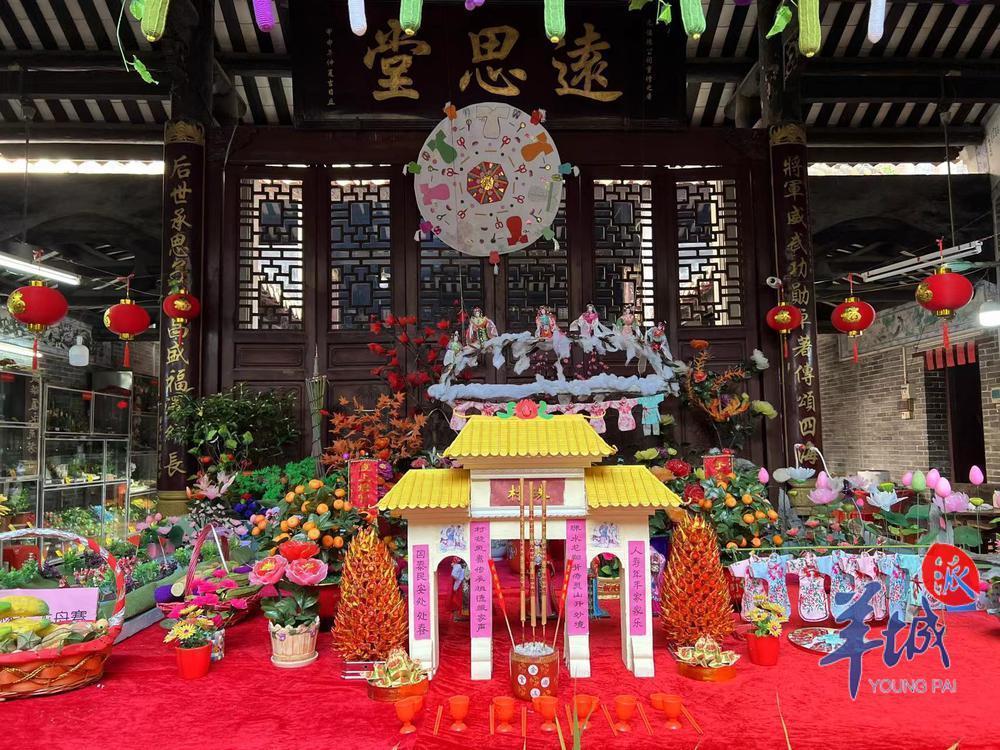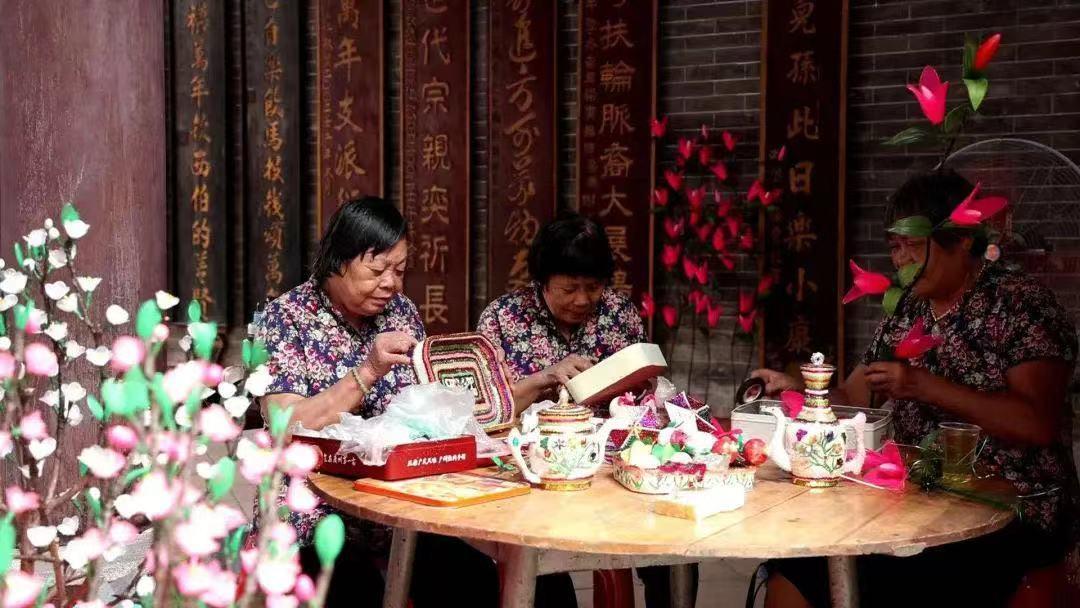

The Qixi Festival, also known as the Chinese Valentine's Day, is drawing near on the seventh day of the seventh lunar month. For the people of Guangzhou, this festival holds significant cultural value, with the Zhu Village of Tianhe District standing out as the most concentrated and grandiose hub for Qixi celebrations in the city.
Marking the commencement of the festivities, the "Qixi Tianhe Shines Guangzhou" 2023 Guangzhou Qixi Culture Festival is set to kick off in the first village dedicated to Qixi culture in China – the Zhu Village of Tianhe District. A myriad of vibrant activities will keep the celebrations alive for seven uninterrupted days.

On August 16th, our reporters delved into the heart of the Zhu Village's Yuande Chen Ancestral Hall, immersing themselves in the distinctive and traditional Cantonese Qixi customs.
Around 9 AM, as the crackle of firecrackers filled the air, the Yuande Chen Ancestral Hall transformed into a lively scene. The smoke from incense spiraled upwards, creating an atmosphere of reverence. Several skilled women, known as "Qiao Jie" (legend has it that Zhinv is an adept weaver in the heaven, and women of olden times would seek her guidance each year to acquire her intricate skills) dressed in elegant Hanfu attire, their hands clasped in prayer, eyes closed in devout meditation, partook in the ancient ritual, imploring the Zhinv, a weaver goddess, to descend.

The legacy of Qixi culture is underpinned by generations of perseverance and heritage.
"In ancient times, while men tilled the land, women wove delicate threads. Qixi was our plea to the celestial maiden, Zhinv, for dexterity, which sustained our households," explained Pan Huijun, a prominent "Qiao Jie" of the Zhu Village and a representative inheritor of the "Tianhe Qixi Customs". In days gone by, young women of the Zhu Village would put old fashioned square tables for eight people at their doorsteps or halls, which would be adorned with exquisite handicrafts, vintage treasures, fresh fruits, flowers, and cosmetics in a display called"Bai Qi Niang". Nowadays, during Qixi Festival, these skilled women gather in the ancestral hall, arranging elaborate displays featuring traditional deities, flora and fauna, fine fruits, as well as modern pieces like the Guangzhou Tower and Ice Dune sculptures for all to admire.
Pan Huijun introduced the three essential elements of a "Bai Qi Niang": the "Qi Niang Plate", the "Magpie Bridge", and the model of "Zhu Village Memorial Gate", all unique to the Zhu Village. Beneath the "Yuan Si Tang" plaque, the "Qi Niang Plate" is suspended, adorned with symbols of the maiden's trade like clothes, scissors, golden hairpins, and mirrors, signifying the craftswomen's prowess to the goddess. Beneath the "Qi Niang Plate", the scene of Niulang (a Cowherd) and Zhinv meeting on the Magpie Bridge is depicted, symbolizing unwavering love. The model of"Zhu Village Memorial Gate" stands as a testament to the village's commitment to preserving Qixi culture.

Pan Huijun presented a "vegetarian pagoda" made from ingredients like winter mushrooms, cloud ear fungus, dried lily buds, dried bean-curd sticks, and vermicelli. Dried lily buds and vermicelli represent silver needles and silk threads, respectively, alluding to deft needlework and creativity. The dried bean-curd sticks symbolize contentment and joy, encapsulating a way of life.
Over the years, Pan Huijun has been dedicated to introducing intangible cultural heritage into schools, allowing more young people to understand and continue this traditional culture. Nowadays, Qixi Festival not only attracts experienced "Qiao Jie", but also engages numerous young individuals, including the emergence of young "Qiao Ge", or skilled men.
Fourteen-year-old Sun Haipeng, an eighth-grade student, actively participated in creating several Qixi crafts for the "Bai Qi Niang" at the Yuande Chen Ancestral Hall this year. "Engaging in handicrafts helps me find tranquility; I enjoy the process, and witnessing the final product brings a sense of accomplishment," expressed Sun Haipeng.
广州乞巧文化节开幕式将于8月17日晚举行
农历七月初七乞巧节将至,广州人历来重视该节日,天河珠村是目前广州乞巧活动最集中、规模最大的村落。
8月17日晚,“七夕天河 出彩广州”2023广州乞巧文化节将在中国乞巧第一村——天河珠村正式开幕,多彩活动七天不间断。
8月16日,记者提前探营珠村元德陈公祠,沉浸式体验独具特色的传统广府乞巧习俗。
上午9时许,随着鞭炮声响起,元德陈公祠一下子变得热闹起来。香烛上的烟雾徐徐腾升,数名巧姐身着传统汉服,双手合十,闭目默祷,虔诚地完成拜祭古礼,恭请七娘下凡。
乞巧文化传承背后,是一代又一代人的坚守和传承。
“古时男耕女织,乞巧就是乞求仙女赐巧手给我们,可以维持家计。”潘慧君说,她是珠村有名的“巧姐”,也是“天河乞巧习俗”的代表性传承人。据了解,旧时乞巧节,珠村姑娘们在家门前或厅堂中摆设八仙桌,摆放自己制作的手工艺品,配上古董珍玩、鲜花水果和胭脂红粉,这就是“摆七娘”。如今的乞巧节,巧姐齐聚祠堂,在祠堂内摆设大案台,摆放传统的仙女、花鸟、佳果以及现代的广州塔、冰墩墩等各种精致手工艺品供人观赏。
潘慧君介绍,“摆七娘”有必不可少的“三件宝”,即七娘盘、鹊桥和珠村牌坊,这也是珠村独有的特色。其中,七娘盘高高悬挂在“远思堂”牌匾下方,上面贴有七娘衣、剪刀、金钗、梳妆镜等用具,寓意向仙女展示巧姐的巧手;“七娘盘”下展现了七仙女与牛郎的鹊桥相会场景,寓意忠贞不渝的爱情;而“珠村牌坊”则代表珠村对乞巧文化的传承。
潘慧君拿起由冬菇、云耳、金针、支竹、粉丝组成的斋塔向记者介绍,金针和粉丝代表“银针”和“丝线”,寓意穿针引线、心灵手巧;“支竹”则寓意知足常乐,体现一种生活态度。
多年来,潘慧君不断在学校开展非遗进校园的传承课,让更多年轻人了解和传承这一传统文化。如今的乞巧节,不仅有年长的巧姐,还吸引了很多年轻人加入,甚至还有年轻的“巧哥”。
14岁的孙海鹏是一名初二学生。今年元德陈公祠的“摆七娘”中,他参与制作了多个乞巧作品。“做手工可以让自己静下心来,因为很享受这个过程,而且看到成品后会有一种成就感。”孙海鹏说。
文、图|羊城晚报全媒体记者 符畅 实习生 裴承艳 张顺强
翻译|刘佳慧
责编 | 王瑜瑛
-
Guangzhou Qixi Culture Festival to be held on August 17th
2023-08-17 23:54:57 -
Guangdong's urban employment increased by 828,600 people from January to July 2023
2023-08-17 23:54:40 -
2023 China Digital Economy Innovation and Development Conference kicks off in Shantou
2023-08-17 23:54:18 -
Video|Commercial Counselor of the Chinese Consulate-General in Almaty (Kazakhstan):China-Europe Railway Express will run faster and better
2023-08-17 13:17:43






